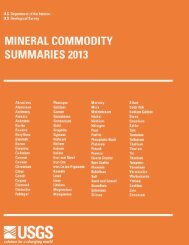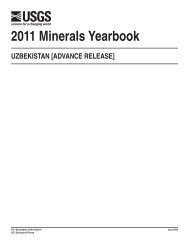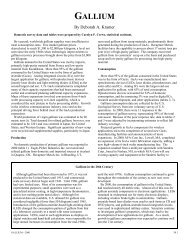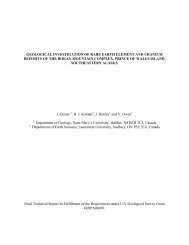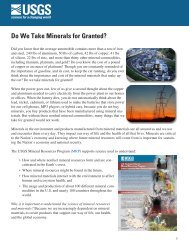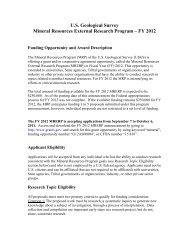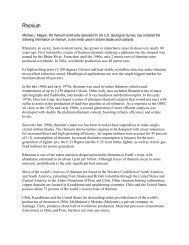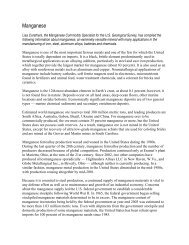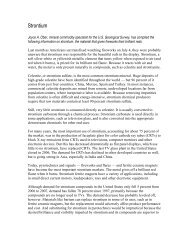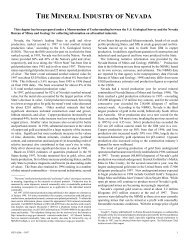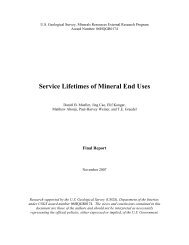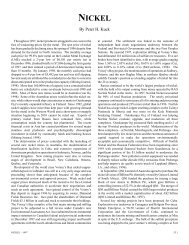Mineral Commodity Summaries 2003 - Mineral Resources Program ...
Mineral Commodity Summaries 2003 - Mineral Resources Program ...
Mineral Commodity Summaries 2003 - Mineral Resources Program ...
You also want an ePaper? Increase the reach of your titles
YUMPU automatically turns print PDFs into web optimized ePapers that Google loves.
ZIRCONIUM AND HAFNIUM<br />
Government Stockpile: The National Defense Stockpile (NDS) shipped 16,182 metric tons (17,838 short tons) of<br />
zirconium ore (baddeleyite) during fiscal year 2002. The U.S. Department of Energy (DOE) held over 500 tons of<br />
zirconium in various forms. DOE also maintained a stockpile of approximately 35 tons of hafnium.<br />
Events, Trends, and Issues: The global supply and demand of zirconium mineral concentrates was largely balanced<br />
in 2002. This trend is expected to continue over the next few years. In the long-term, however, supply shortages may<br />
occur unless new production sources of zirconium concentrates are developed. U.S. imports of zirconium ores and<br />
concentrates were estimated to have decreased by 47%, while exports were estimated to have decreased by 58%<br />
compared with those of 2001. A mining operation at Green Cove Springs, FL, is nearing the end of its mine life, and<br />
dredging at the site will be phased out over the next few years. Smaller economic deposits surrounding the main<br />
mined-out ore body will continue to be mined with a mobile mining unit and concentrator. The mining and processing<br />
operations at Green Cove Springs will be moved to a new deposit in northern Florida and southern Georgia and are<br />
scheduled to commence in <strong>2003</strong>. A new zircon finishing plant was installed at Stony Creek, VA, to improve and<br />
upgrade product quality. The plant was completed in the fourth quarter of 2002. The availability of hafnium continued<br />
to exceed supply. Surpluses were stockpiled in the form of hafnium oxide. The demand for nuclear-grade zirconium<br />
metal, the production of which necessitates hafnium’s removal, produces more hafnium than can be consumed by its<br />
markets.<br />
World Mine Production, Reserves, and Reserve Base: World primary hafnium production statistics are not<br />
available. Hafnium occurs with zirconium in the minerals zircon and baddeleyite. Reserves and reserve base<br />
estimates for Brazil and China have been increased based on new information from those countries.<br />
Zirconium Hafnium<br />
Mine production Reserves 7 Reserve base 7<br />
Reserves 7<br />
Reserve base 7<br />
(thousand metric tons)<br />
2001 2002<br />
(million metric tons, ZrO2) (thousand metric tons, HfO2) e<br />
United States 1<br />
100 100 3.4 5.3 68 97<br />
Australia 400 400 9.1 30 180 600<br />
Brazil 30 30 2.2 4.6 44 91<br />
China<br />
e<br />
15 15 0.5 3.7 NA NA<br />
India 12 12 3.4 3.8 42 46<br />
South Africa 250 260 14 14 280 290<br />
Ukraine<br />
e 75 72 4.0 6.0 NA NA<br />
Other countries 23 30 0.9 4.1 NA NA<br />
World total (rounded) 900 910 37 72 610 1,100<br />
World <strong>Resources</strong>: <strong>Resources</strong> of zircon in the United States included about 14 million tons associated with titanium<br />
resources in heavy-mineral sand deposits. Phosphate and sand and gravel deposits have the potential to yield<br />
substantial amounts of zircon as a future byproduct. Eudialyte and gittinsite are zirconium silicate minerals that have a<br />
potential for zirconia production. Identified world resources of zircon exceed 60 million tons.<br />
<strong>Resources</strong> of hafnium in the United States are estimated to be about 130,000 tons, available in the 14-million-ton<br />
domestic resources of zircon. World resources of hafnium are associated with those of zircon and baddeleyite and<br />
exceed 1 million tons.<br />
Substitutes: Chromite and olivine can be used instead of zircon for some foundry applications. Dolomite and spinel<br />
refractories can also substitute for zircon in certain high-temperature applications. Columbium (niobium), stainless<br />
steel, and tantalum provide limited substitution in nuclear applications, while titanium and synthetic materials may<br />
substitute in some chemical plant uses.<br />
Silver-cadmium-indium control rods are used in lieu of hafnium at numerous nuclear powerplants. Zirconium can be<br />
used interchangeably with hafnium in certain superalloys; in others, only hafnium produces the desired or required<br />
grain boundary refinement.<br />
e Estimated. NA Not available. W Withheld to avoid disclosing company proprietary data.<br />
1 Rounded to one significant digit to avoid disclosing company proprietary data. ZrO2 content of zircon is typically 65%.<br />
2<br />
Includes germanium oxides and zirconium oxides.<br />
3<br />
E.I. du Pont de Nemours & Co. and Iluka <strong>Resources</strong>, Inc., average price.<br />
4<br />
U.S. Census Bureau trade data.<br />
5<br />
American Metal Market, daily, Miscellaneous prices. Converted from pounds.<br />
6 Defined as imports - exports.<br />
7 See Appendix C for definitions.<br />
193<br />
U.S. Geological Survey, <strong>Mineral</strong> <strong>Commodity</strong> <strong>Summaries</strong>, January <strong>2003</strong>



